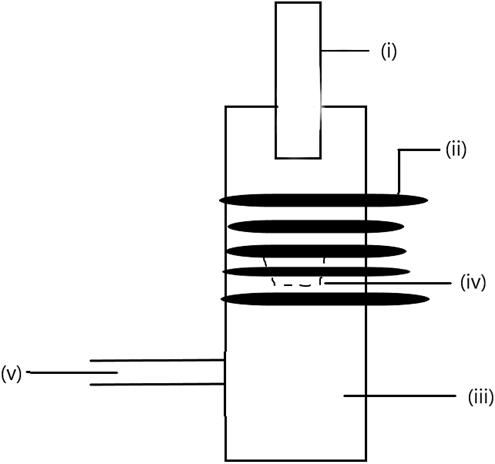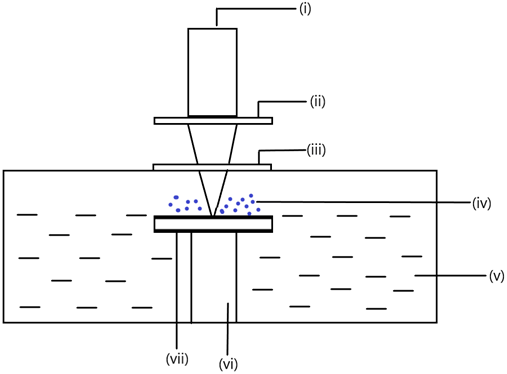This set of Nanotechnology Multiple Choice Questions & Answers (MCQs) focuses on “Synthesis of Nanoparticles – Set 2”.
1. Which method of formation of nanoparticle uses surfactant, radical scavenger, and soluble metal salt during the procedure?
a) Radiolysis method
b) Chemical method
c) Epitaxial growth
d) Restacking method
View Answer
Explanation: The formation of nanoparticles using the radiolysis method uses a minimum of chemicals during the procedure. These include water, a soluble metallic salt, a surfactant and a radical scavenger. This method allows for the tailoring of particle shape and size by modifying the precursor concentrations.
2. Label the marked parts of the apparatus for synthesis of nanoparticles using RF – produced plasma.

a) i) = Collector rod; iii) = Evacuated chamber
b) ii) = Evacuated chamber; iv) = Container with metal
c) iii) = He Gas; v) = Collector rod
d) iv) = RF coils; i) = Container with metals
View Answer
Explanation: The diagram is an illustration of the apparatus required for the synthesis of nanoparticles using RF – produced plasma. The labellings are – i) Collector Rod; ii) RF coils; iii) Evacuated chambers; iv) Container with metal; v) Helium Gas
3. Identify a reducing agent that is most commonly used for the production of nanoparticles of Molybdenum.
a) K2Cr2O7
b) LiAlH4
c) NaBEt3H
d) C2H2O4
View Answer
Explanation: Nanoparticles of Molybdenum are made chemically. The metal is reduced in toluene solution with NaBEt3H, at room temperature, to yield (Mo) nanoparticles in large amounts. The dimension of the synthesized product ranges between 1 and 5nm usually. The chemical reaction is
MoCl3 + 3NaBEt3H ➔ Mo + 3NaCl + 3BEt3 + (3/2)H2
4. Pick the odd one out.
a) Thermolysis
b) Calendering
c) Extrusion
d) Thermoforming
View Answer
Explanation: Thermolysis is a method of producing nanoparticles by their decomposition at high temperatures. Calendering and thermoforming are various polymer processing techniques that form a usable product out of the different polymers – artificial or natural.
5. What is used to detect the presence of nanoparticles in Thermolysis?
a) EPR
b) MT
c) ECG
d) OTG
View Answer
Explanation: The presence of nanoparticles can be detected using electron paramagnetic resonance (EPR) of the conduction electrons present in the metals. EPR uses microwave radiations to detect nanoparticles. But these waves have low – penetration depth in metals which prevent the observation of the EPR of the conduction electrons. However, in the collection of nanoparticles there is a hike in the surface area which has a size of the order of the penetration depth. Eventually, EPR of the electrons can be detected.
6. Select a compound from the given options that is not used for the synthesis of aluminium nanoparticles.
a) Me2EtNAlH3
b) Ti{OCH(CH3) 2}4
c) C6H5CH3
d) NaBH4
View Answer
Explanation: Aluminium nanoparticles can be obtained by decomposing [Me2EtNAlH3] in toluene (C6H5CH3) . The solution can be heated to 105°C for about two hours, followed by the addition of Titanium isopropoxide {Ti[OCH(CH3)2]4}. This results in the formation of nanoparticles whose size depends on the choice of catalyst. Sometimes, a surfactant such as oleic acid can also be added to the solution to prevent the aggregation of particles.
7. Find out a disadvantage of the ball milling process used for the nanoparticle production.
a) Mills highly abrasive materials
b) Continuous operation
c) Contamination of product
d) Toxic materials are milled.
View Answer
Explanation: Ball milling is a mechanical, top – down process of producing nanoparticles. It is a continuous method that can mill highly abrasive and even toxic materials. However there are several pitfalls of this method – a) longer milling time, b) Contamination of product owing to wear and tear of the balls and partially of the casing, c) High machine noise and d) Difficulty in maintenance of the mill.
8. Biopolymers can be disintegrated to form anisotropic nanoparticles.
a) True
b) False
View Answer
Explanation: Biopolymers such as lignin, starch and chitin can be broken down to nanoscale giving anisotropic fiber or needle – like nanoparticles. The disintegration of biopolymers can be done mechanically accompanied by enzymatic treatment and oxidation of substances to enhance the breakdown.
9. Which of the following is not a method of synthesis of nanoparticles?
a) Attrition
b) Pyrolysis
c) Spectroscopy
d) RF Plasma
View Answer
Explanation: There are various methods applied for the synthesis of nanoparticles. Attrition, Pyrolysis, RF Plasma, Ball milling and Inert gas condensation are few techniques among them. However, Spectroscopy is a method of characterization of nanoparticles.
10. Label the diagram for the production of metal nanoparticles using pulsed laser beam.

a) i) = Rotating substrate; ii) = Si nanoparticles
b) (iii) = Protective window; (iv) = Ag nanoparticles
c) (v) = Solution; (vi) = Pulsed laser beam
d) (vi) = Focusing lens; (ii) = Rotating sample holder
View Answer
Explanation: The labellings of the given diagram for nanoparticle production using pulsed laser methods are: – (i) Pulsed laser beam; (ii) Focusing lens; (iii) Protective window; (iv) Ag nanoparticles; (v) Silver nitrate solution; (vi) Rotating sample holder and (vii) Rotating disk substrate.
Sanfoundry Global Education & Learning Series – Nanotechnology.
To practice all areas of Nanotechnology, here is complete set of 1000+ Multiple Choice Questions and Answers.
If you find a mistake in question / option / answer, kindly take a screenshot and email to [email protected]
